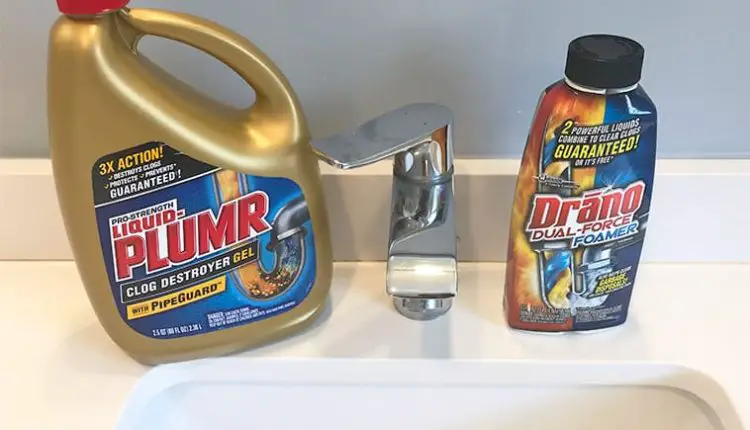How Does Drano Work | Unblocking the Mystery
Articles, products, and services offered on this site are for informational purposes only. We are part of the Amazon Services LLC Associates Program, an affiliate advertising program. Amazon.com is compensated for sales resulting from links on our website.
Please review our disclaimer before acting based on anything you read or see.
Drano is a chemical drain cleaner designed to dissolve clogs and clear pipe blockages. “How Does Drano Work?” It is formulated with a powerful combination of ingredients that work together to break down and remove the substances causing the clog. Drano is typically used for unclogging kitchen and bathroom drains, such as those that are clogged with hair, soap scum, grease, or food particles.
The main active ingredients in Drano are sodium hydroxide and sodium hypochlorite. Sodium hydroxide, or caustic soda or lye, is a strong base that can dissolve organic matter, such as hair and grease. Sodium hypochlorite, commonly known as bleach, is a powerful oxidizing agent that can break down and remove stains and organic material.
How Does Drano Work
Using Drano to unclog drains is a straightforward process that anyone can do. Here is a step-by-step guide on how to use Drano effectively:
Safety First
Before using Drano, it is important to take some safety precautions. Wear protective gloves and goggles to protect your skin and eyes from any potential splashes or spills. Also, ensure that you keep children and pets away from the area where you will be using Drano.
Remove Standing Water
If standing water is in the sink or tub, remove as much as possible using a cup or bucket. Drano works best when no standing water is blocking its path to the clog.
Measure and Pour
Carefully measure the recommended amount of Drano for your specific drain size. Typically, it would be best to pour half a bottle (about 16 ounces) of Drano into the clogged drain. Slowly pour the Drano into the drain, avoiding any splashes.
Wait and Flush
Allow the Drano to work its magic by letting it sit in the drain for 15 to 30 minutes. During this time, the chemical reaction between the sodium hydroxide and sodium hypochlorite will break down the clog and dissolve any organic matter. After the designated time has passed, flush the drain with hot water to help clear away any remaining debris.
Repeat if Necessary
Sometimes, a single application of Drano may not be enough to clear the clog completely. If you still notice slow drainage or a partial blockage, you can repeat the process by pouring another half bottle of Drano into the drain and waiting for the recommended time before flushing again.
Alternative Solutions to Unclog Drains
While Drano is a popular and effective drain cleaner, there are alternative solutions that you can try if you prefer a more natural or DIY approach. Here are a few options:
- Baking Soda and Vinegar: Mix baking soda and vinegar in equal parts to create a foaming reaction. Pour the mixture into the clogged drain and let it sit for about 30 minutes. Follow up with hot water to flush away the debris.
- Boiling Water: Boil a kettle of water and carefully pour it down the drain in stages. The hot water can help dissolve grease and flush away minor clogs.
- Plunger: Use a plunger to create suction and dislodge the clog. Place the plunger over the drain and firmly push and pull to create pressure. Repeat the process several times until the drain clears.
- Wire Hanger: Straighten a wire hanger and create a small hook at one end. Insert the hooked end into the drain and use it to remove any debris or hair that may be causing the clog.
Remember that these alternative solutions may not be as effective as Drano for severe clogs, but they can be a safe and eco-friendly option for minor blockages.
My Opinion
In conclusion, Drano is a powerful drain cleaner that combines chemicals to dissolve and remove clogs in pipes. Its main ingredients, sodium hydroxide, and sodium hypochlorite, break down organic matter and clear blockages. When used correctly, Drano can effectively unclog drains and keep them running smoothly.
However, using Drano and other chemical drain cleaners with caution is important. Always follow the instructions provided on the label and take necessary safety precautions. In addition, Drano should be used as a reactive measure to clear existing clogs rather than as a preventive measure. Regular drain maintenance, such as using drain screens and cleaning traps, can help prevent clogs from occurring in the first place.
If you are facing a stubborn clog that cannot be cleared with Drano or other DIY methods, it may be time to seek professional help. A licensed plumber will have the expertise and tools to tackle even the most challenging drain blockages.
Remember, a little prevention and regular maintenance can go a long way in keeping your drains clear and functioning properly. By understanding how Drano works and exploring alternative solutions, you can be prepared to tackle any clog that comes your way.



Comments are closed.